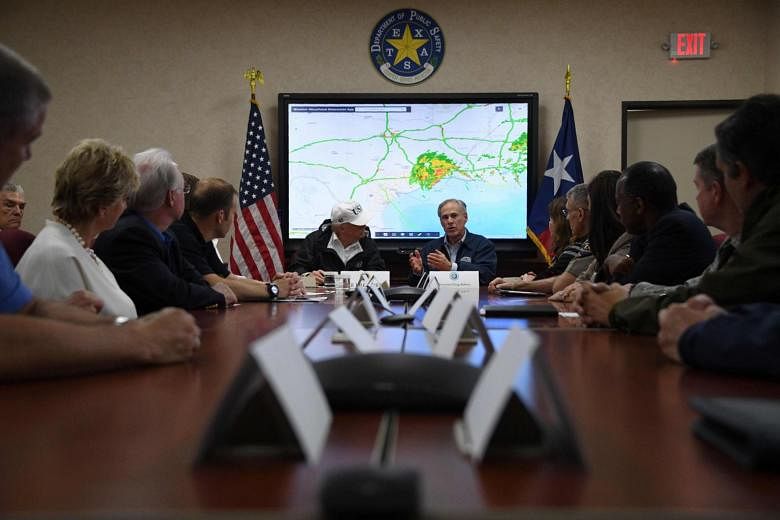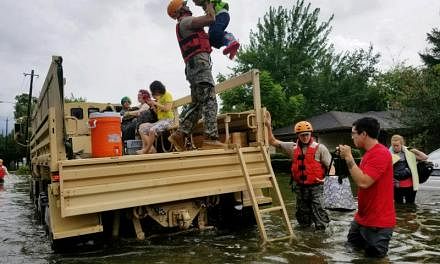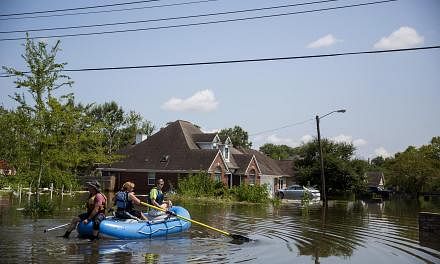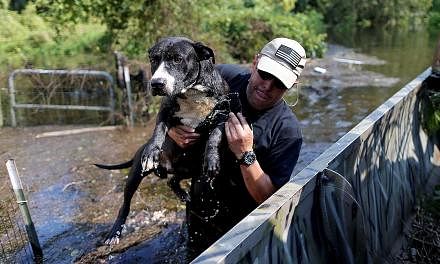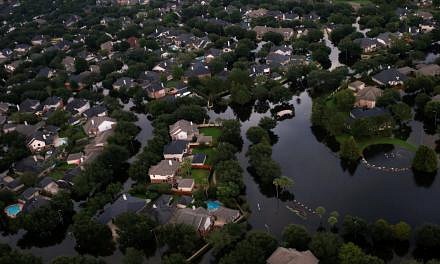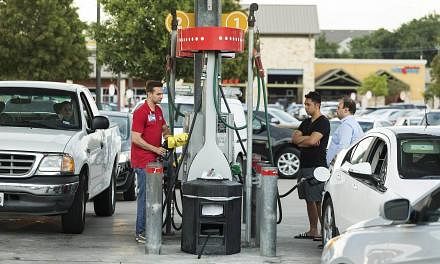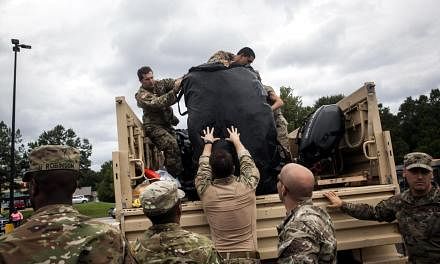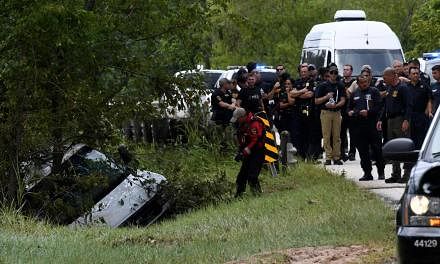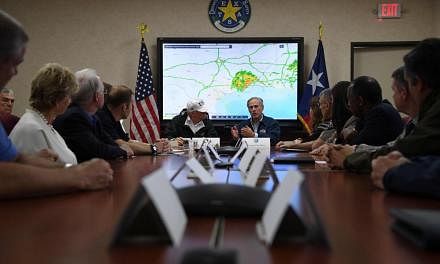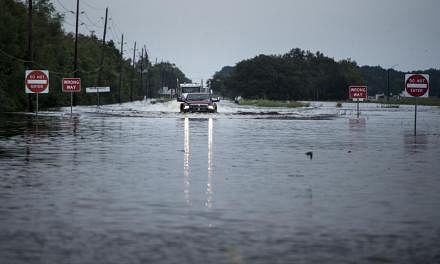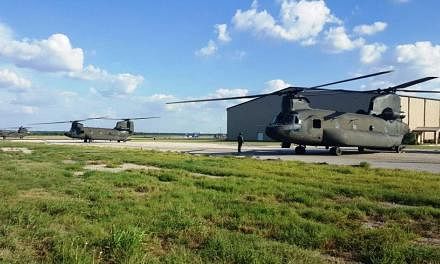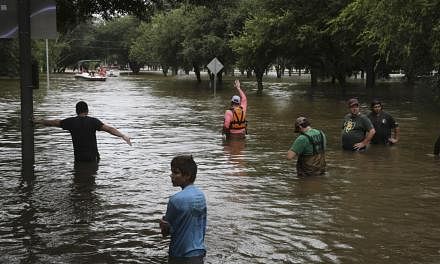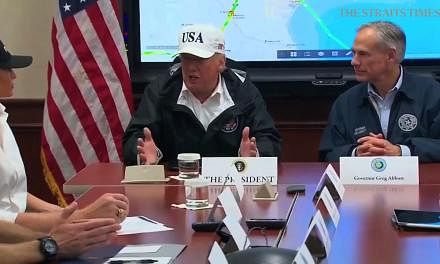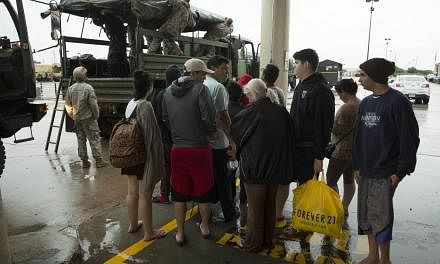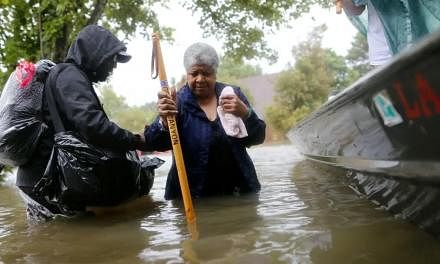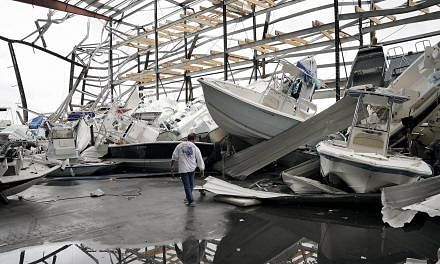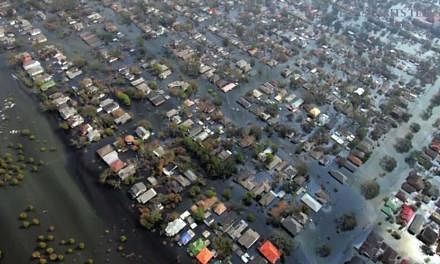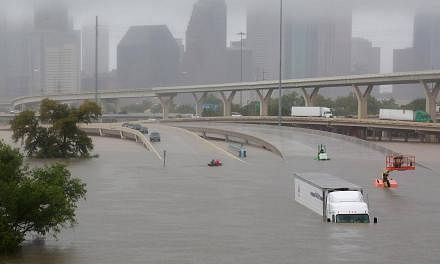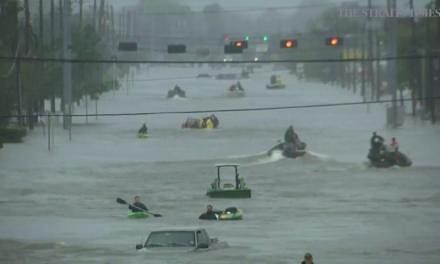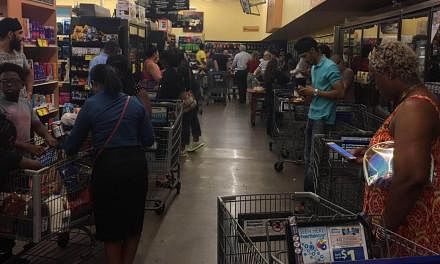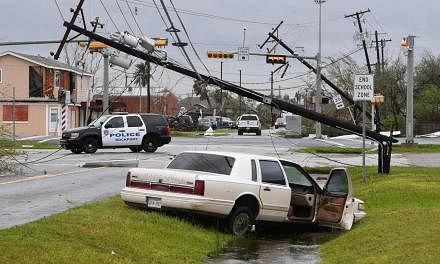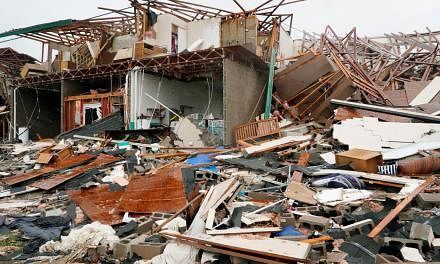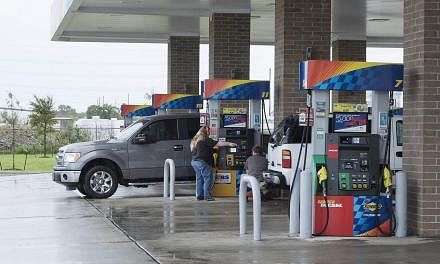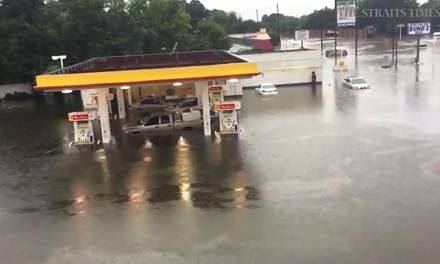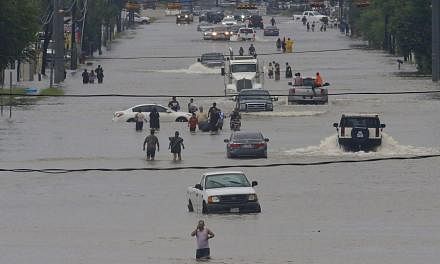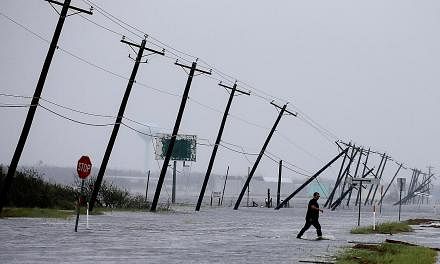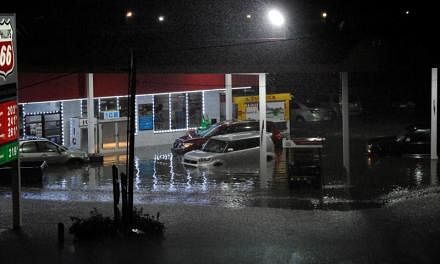HOUSTON (Washington Post) - The devastating storm once known as Hurricane Harvey, already the biggest rainstorm in the history of the continental United States, delivered another punishing wave of rain on Wednesday (Aug 30) to Texas and Louisiana.
Five days after roaring ashore in Texas - leaving behind more than 24 trillion gallons of water, disastrous flooding across the Houston region and a mounting death toll that had grown to at least 37 people - Harvey made landfall before dawn on Wednesday near tiny Cameron, Louisiana, and began grinding its way north-east.
Now a tropical storm and expected to weaken over land, Harvey's immediate impact is not expected to pack the same destructive power as when it slammed into Texas as a Category 4 hurricane last week and dropped foot after foot of rain.
But forecasters said the danger was far from over, and alarming amounts of rainfall in Texas battered cities such as Beaumont and Port Arthur. The National Weather Service warned on Wednesday that "catastrophic and life-threatening flooding will continue in and around Houston eastward into south-west Louisiana for the rest of the week".
The service also warned that "expected heavy rains spreading north-eastward from Louisiana into western Kentucky may also lead to flash flooding" across those areas, imperilling a new swathe of the population.
Texas Governor Greg Abbott said on Wednesday that officials were "immediately deploying far more" members of the National Guard to south-east Texas in response to what he called "emergency conditions" there.
"The worst is not yet over for south-east Texas as far as the rain is concerned," Mr Abbott, a Republican, said at a briefing on Wednesday.
According to the Capital Weather Gang, the Beaumont and Port Arthur area east of Houston saw more than 66cm of rainfall on Tuesday alone, pushing rain totals to more than 119.3cm since Friday. That gave the area a new annual record for rainfall - with four months still left to go in 2017.
Mr Abbott said the total National Guard deployment across Texas would reach 24,000 troops, with about 10,000 of them deployed there from other states.
The rain in Port Arthur, a city in Jefferson County, was so powerful that a shelter there reportedly evacuated after flooding.
Refineries in the city, including a Motiva facility that is the country's largest, were shuttered. The Jefferson County Sheriff's Office, in a message it posted online for Port Arthur, said the city was being "inundated" with hundreds of rescue calls.
"Many homes in Port Arthur are flooding and people are becoming trapped," the sheriff's office said in a message on Facebook. First responders and volunteers alike had taken to boats to rescue people, they said.
It rained so hard on Tuesday night in Port Arthur Texas that Ms Tiffany Hamilton, a former city councilwoman, wondered if hail was pounding her windows. But it was just rain, and by Wednesday morning, most of the city was covered in several feet of water.
Reached by phone, Ms Hamilton described a desperate scene as emergency officials struggled to get enough boats into this city of 55,000 people.
"Family, friends we need boats. We need large trucks, and we need generators," said Ms Hamilton, 37, who is helping coordinate relief efforts in a city that is also without electricity. "The entire city has been flooded."
On Wednesday afternoon, Houston's ABC affiliate aired video of emergency workers trying to evacuate dozens of bedridden patients from a nursing home. Some patients were still hooked up to their oxygen tanks while others sat in their wheel chairs, their feet covered by water. Ms Hamilton said similar scenes were unfolding across the city, although she was hopeful late on Wednesday that the water was showing the first signs of receding.
Much of Port Arthur was under between 3 and 6 feet of water and is so saturated that even the shelters had to be evacuated on Tuesday night, said Ms Danielle Pardue, marketing and communications manager for Christus Southeast Texas Health system.
Ms Pardue wasn't sure of the exact number of people in the shelters, but said it was in the hundreds and possibly thousands.
"They just have to keep moving people from one shelter to the next," Ms Pardue said in a telephone interview. "This entire area is just devastated."
Early on Wednesday morning, two children separated from their parent were brought in by the Coast Guard. They arrived in blankets at the Port Arthur hospital, Ms Pardue said. They were not injured, she said, but eager to find their family.
In Orange, Texas, which sits east of Beaumont on the border with Louisiana, the water began rising at 3am on Wednesday. It crept over the streets and then the residential lawns before it began pushing into homes, rising alongside cars and trapping scores in their homes.
"It was unbelievable," said Ms Robin Clark, who was ferried, along with her wheelchair-bound mother and three dogs, out of her home on a volunteer's boat.
As Harvey moved through the Gulf Coast, storm-battered Louisiana - where memories of Hurricane Katrina, which made landfall in the state 12 years ago this week, are still fresh - hunkered down, evacuating hundreds of people and deploying the Louisiana National Guard.
Louisiana Governor John Bel Edwards (D), in a news briefing on Wednesday, said the threat of flooding appeared to be decreasing in south-west Louisiana, but he reminded people that the storm would linger over the state throughout the day.
"South-west Louisiana for now remains the centre of gravity as it relates to this storm in Louisiana," he said.
Cautioning people to remain alert, he added: "Somewhere between being complacent and being panicked is the right place, and that's where we're going to ask the people of Louisiana to settle."
Flash flood warnings were issued across eastern Texas and western Louisiana, areas facing mounting rainfall totals as Harvey continued its onslaught. Parts of Interstate 10 near Beaumont, Texas, were swallowed up by floodwaters - with road signs poking above the wind-driven chop.
About 80.4km to the east, Lake Charles, Louisiana, had seen more than a foot of rain, and forecasts say the downpours are expected to continue. A storm surge warning was posted across the coast of southern Louisiana, from Holly Beach to Morgan City.
Between 400 and 500 people were evacuated from Calcasieu Parish, Mr Dick Gremillion, director of the parish's office of homeland security and emergency preparedness, said at a briefing on Tuesday night.
"There is high water just about every section of the parish," he said. "If we get 3 (inches) to 5 (inches) of rain, it's probably going to be in the entire parish."
The storm's path at least appeared to offer a break to New Orleans, which this week postponed Katrina remembrance events due to Harvey.
"By the grace of God, this is going to miss us," New Orleans Mayor Mitch Landrieu told CNN on Wednesday.
Harvey's movement up the coast also gave Houston a respite from the heavy rains that have pelted the city since the weekend, even as officials noted it could be years before storm's true toll is known.
More than 127cm of rain over four days had turned the country's fourth-largest city into a sea of muddy brown water, as boats skimmed along what had been neighbourhood streets in search of survivors.
The impact in the Houston area was staggering. Between 25 and 30 per cent of Harris County - home to 4.5 million people in Houston and its near suburbs - was flooded as of Tuesday afternoon, according to Jeff Lindner, a meteorologist with the county flood control district.
That is an area potentially as large as New York City and Chicago combined.
On Wednesday morning, with rain lashing other parts of the Gulf Coast, Houstonians awoke to sunshine for the first time since Harvey arrived. Under voluminous clouds, scores remained without power, debris littered the city and water continue to rise and recede, but the rain, at least, had abated.
Houston's two airports said they were resuming limited flight operations, with full service expected by the weekend.
Clean-up doesn't begin to describe what's next for south-east Texas. On highways that allow for some traffic, large pickups - some outfitted with monster truck-style tires - hauling boats made up the majority of those who dared to travel in recent days.
But now, a few more are venturing out looking for supplies where there may not be any to be had. Others sought to see what Harvey left behind.
"I feel like I'm dreaming," said Ms Julie Steptoe, who ventured on Wednesday morning to an intersection in Kingwood, north of Houston. Never taking her eyes off of the water that engulfed the area, she continued: "I don't know what to think. I'm hoping it turns out okay for everyone."
Even though the heavy rain had departed and glimmers of hope - along with glimpses of the sun - had returned to Houston, officials were still struggling to define the enormity of what had happened.
At least 37 deaths were believed to be related to the storm as of Wednesday afternoon, a number expected to rise as authorities are able to enter flooded homes and cars.
The toll includes Sgt Steve Perez with the Houston Police Department. The 60-year-old veteran officer's body was found early on Tuesday morning, officials said, after he drowned while driving in to work early on Sunday morning during the storm's peak.
"He laid down his life," Houston Police Chief Art Acevedo said during an emotional news briefing on Tuesday.
Other stories of loss, grief and agony began to emerge. Six family members were apparently swept away while trying to escape the storm in a van; the Harris County Sheriff's Office said on Wednesday that they had recovered six bodies from the van.
The medical examiner's office in Harris County said it had recovered 28 bodies - including the people in the van - whose deaths were confirmed or suspected to be linked to Harvey.
Police in Beaumont, Texas, said on Tuesday that a woman and her young child had gotten out of their car on a flooded road and were swept into a canal. When authorities found them, the young girl was clinging to her mother and about to go under a trestle, where they would have been lost for good, police said. The mother died, while the young girl was in stable condition.
Houston Mayor Sylvester Turner imposed a curfew in the city starting on Tuesday from midnight to 5am local time to deter looting of abandoned homes.
"There are some who might want to take advantage of this situation, so even before it gets a foothold in the city, we just need to hold things in check," Mr Turner said at a news conference.
The Federal Emergency Management Agency said on Wednesday that it had more than 230 shelters in Texas housing more than 30,000 people, a number that is expected to change.
More than 195,000 people have registered asking for federal assistance, a number that will likely increase, Mr William "Brock" Long, the FEMA administrator, said during a news briefing.
It will take "many, many years" before the full scope of Harvey's impact is clear, Mr Long added."We expect a many year recovery in Texas and the federal government is in this for the long haul," Ms Elaine Duke, the acting Homeland Security secretary, said at the same briefing on Wednesday.
Ms Duke said she had no answer on Wednesday regarding whether the Trump administration would accept the Mexican government's offer to help.
Later on Wednesday, Secretary of State Rex Tillerson thanked Mexico for its offer, but also did not say whether the United States would accept the aid.
About half a million people will have their homes "impacted in some way" by the storm, Health and Human Services Secretary Tom Price told Fox News.
President Donald Trump has pledged swift federal aid in response to Harvey's devastation. On Wednesday, Mr Abbott, the Texas governor, said that given the sheer number of people and geographic area impacted, he expects the federal government's aid package "should be far in excess" of the roughly US$120 billion in funds allotted for Gulf Coast recovery after Katrina.
Ms Sheila Jackson Lee, a Texas Democrat who represents central Houston, has estimated the federal response will total at least roughly US$150 billion. Mr Trump could request an emergency funding package as soon as next week, a senior administration official said.
Speaking in Missouri on Wednesday, Mr Trump praised the first responders and local officials for their handling of the storm. Mr Trump also made a point of talking about victims of the storm and their suffering, something he did not do during his trip to Texas a day earlier.
Thousands have been rescued amid the churning waters, authorities said. These official tallies of rescues are likely low, leaving out the scores of civilians who took to boats in an effort to rescue neighbours, friends and strangers alike.
In some cases, these attempts ended with tragedy. On Monday morning, five people - three brothers and two of their friends - took a small boat in north-east Houston to rescue anyone they could find. They made two trips and brought two families - seven people in total - to safety.
Then they went out a third time."Everybody told them to stay, that they had already done their part," said Ms Stepheny Jacquez, 25, a family member. "But they said, 'No, we have to go back, there's a lot of people in danger.'"
During that third trip out on Monday afternoon, the group lost control of their boat in strong currents and drifted toward downed power lines throwing off sparks.
"They all jumped in the water and got electrocuted, and the current took them," Ms Jacquez said.
Now two of the men are dead, two are missing and one is in the hospital with electrical burns, Ms Jacquez said."They're heroes; they were just trying to help people," Ms Jacquez said.
Others expressed calm about the storm. Ms Carol Headrick said that when waters began to rise to the height of the front desk lobby at her nursing home in Kingwood, Texas, outside of Houston, rescue crews told her to leave and took her out on a pontoon boat before she had time to grab much of anything.
"I never was scared," said Ms Headrick, 83, as her face shifted from one of feigned outrage at the question to a mischievous smile.
Referring to a previous storm, she added: "I've got my Bible. And God promised he never was going to do this again."
Ms Headrick betrayed no sign of worrying about the storm, because she was too busy deciphering the crackle of her old handheld AM-FM radio to be bothered with worry.
She had to keep her nursing home mates informed as they sat in a U-shaped group in the Kingwood Bible Church's multipurpose room, discussing the Louisiana State University Tigers, her favourite team.
She was happy with the sandwiches she was given and grateful for the care from volunteers and to still be among her friends.
"Last week, they gave us these special glasses to watch the eclipse and who would have thought we'd be here now," she said.
Around Houston and beyond, schools and universities were closed, with some unable to say when they would reopen. The storm had pushed water to spill over in reservoirs west of downtown Houston, raising fears that the overflow would eventually make its way to the soaked downtown.
But officials said on Wednesday this was unlikely. Mr Lindner, the Harris County flood control meteorologist, said the reservoirs had stabilised and authorities were more optimistic that significant water would not make its way downtown.
The Army Corps of Engineers and Houston flood-control officials said at a news conference on Wednesday water-levels in the city's bayous and reservoirs were peaking and new flooding citywide should be less than initially feared.
Mr David Russo, of the Army Corps of Engineers, said that the water is no longer predicted to escape the Barker Reservoir, while water from the Addicks Reservoir - which overflowed its spillway on Tuesday - was diminishing.
Thousands of homes near the reservoirs are inundated or under water, some of it reaching as high as six feet, Mr Lindner said. But while water may yet rise in some areas, structures that have not been inundated are less likely to flood, he said.
Mr Linder said water levels in several other key Houston waterways, including Lake Houston, have also peaked."The watersheds are falling, and while most of them remain well over their levels, and some remain at record levels, the water levels are going down," Mr Linder said.
But he cautioned that some homes already under water may "degrade".
Flood officials quickly followed their news conference by urging people in the Inverness Forest subdivision to leave because a levee protecting it might be over-topped.
A group of firefighters in Houston responded to a house fire, wading in chest-deep water to put it out after the family was rescued inside. But they struggled to find fire hydrants and could not get enough water pressure, so they eventually resorted to pointing the boat's engine toward the house and using it to spray a massive stream of water, putting out the fire.
Across Texas, the storm shut down 14 oil refineries, causing damage at some that released harmful chemicals.
In Crosby, Texas, a fertiliser plant was in critical condition on Tuesday night after its refrigeration system and inundated backup power generators failed, raising the possibility that the volatile chemicals on the site would explode.
Arkema, a maker of organic peroxides, evacuated all the personnel from the plant and was attempting to operate the facility remotely. The material must be kept at low temperatures to avoid combustion.
As scores were forced from their homes, massive venues opened their doors to house people. The George R. Brown Convention Centre in downtown Houston, which next month was scheduled to host a concert as well as a "High Caliber Gun & Knife Show," had taken 10,000 people as of Tuesday morning, double the expected capacity.
Houston then opened what the mayor had called other "mega shelters", turning to the NRG Centre, a convention centre near the old Astrodome, and the Toyota Centre, home of the Houston Rockets basketball team.
About 402.3km to the north, the city of Dallas was preparing to take at least 6,000 evacuees from the Houston area, according to Dallas County Judge Clay Jenkins, the county's top official. There were showers, phone-charging stations, and a dining hall manned by volunteers, including the Texas Baptist Men and local Israeli-American and Muslim-American groups.
The Dallas shelter was still mostly empty on Tuesday because the storm was too bad to get evacuees out of Houston.
"The planes are grounded, so we can't get C-130s in" with evacuees, said Mr Jenkins, a Democrat. "The roads are covered with water, so we can't get buses in."
Dallas housed 28,000 evacuees after Hurricane Katrina in 2005, Mr Jenkins said. He said he's not sure if that many will come this time."We don't know what we'll get," he said, "until the water recedes."
